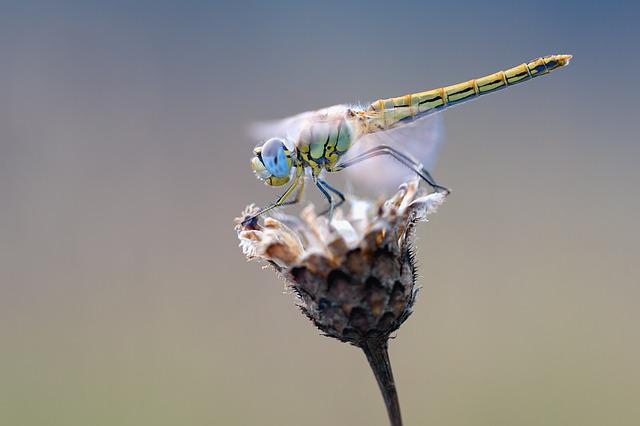
Insects have tiny bodies, some do not exceed a centimeter in length. Many individuals are curious if insects have brains and, if they do, what they use them for.
When you prepare to swat a fly or a cockroach, it frequently dodges your attack, implying that they possess minds and perceptions.
However, when you strike a mosquito, all you see is the blood that they may have sucked from you.
Cockroaches, for example, may live for a few more days with a severed head, suggesting that their brains are less important than human brains.
Apart from the basic question of having a brain, we can’t help but wonder if insects are intelligent. There are several questions to consider when it comes to insects and intelligence.
This essay will delve into the insect brain in-depth and explain its critical function in the insect’s existence.
Do insects have brains?
The short answer is yes, insects have brains.
However, their brains are very different from ours. For example, our brain is divided into two hemispheres, while an insect’s brain only has one.
The human brain also has four lobes – the frontal lobe, the temporal lobe, the parietal lobe, and the occipital lobe. An insect brain only has three – the antennal lobe, the optic lobe, and the protocerebrum.
The size of an insect’s brain is also very different from ours.
The average human brain weighs about 3 pounds (1.4 kg). The largest insect brain on record belongs to the giant goliath beetle and weighs in at 0.04 ounces (1.2 g). That’s about 1/70,000th the size of a human brain!
In spite of their small size, insect brains are very complex. They may not be as big or as sophisticated as ours, but they are well-suited to the needs of insects.
Read also: How Do Frogs Survive Winter
What do insect brains do?
Insect brains are responsible for all of the basic functions that our brain performs, such as controlling the body, processing information from the senses, and coordinating movement.
Insect brains are also capable of more complex feats, such as learning and memory.
While the human brain is primarily responsible for higher-level functions such as reasoning and decision-making, the insect brain is more focused on survival.
This makes sense when you consider the fact that insects have been around for millions of years longer than humans have. They have had to adapt to changing environments and find ways to survive against predators.
The insect brain is very efficient at performing these basic functions. This is likely due to the fact that it is much simpler than the human brain.
For example, the human brain has billions of neurons, while the insect brain only has a few hundred thousand.
Despite its simplicity, the insect brain is capable of some pretty amazing feats. For example, bees can memorize the location of hundreds of flowers and find their way back to the hive.
They can also communicate the location of these flowers to other bees.
Ants are another example of insects with impressive cognitive abilities. They are able to find their way back to their nest after foraging for food.
They can also communicate with each other using a sophisticated system of chemical signals.
Some scientists believe that the insect brain is so efficient because it is organized differently than the human brain. For example, the human brain has a central nervous system, which consists of the brain and the spinal cord.
The insect brain, on the other hand, is spread out throughout the body. This decentralized structure allows insects to process information more quickly and respond more quickly to changes in their environment.
Read also: What Would Happen If Mosquitoes Went Extinct

What are the three lobes of the insect brain?
The three lobes of the insect brain are the antennal lobe, the optic lobe, and the protocerebrum.
The antennal lobe
The antennal lobe is a region of the brain that is responsible for processing information from the antennae. This information includes both smell and touch.
The antennal lobe is important for helping an animal to navigate its environment and to find food. In many insects, the antennal lobe is also responsible for mating behavior.
The optic lobe
The optic lobe is a brain structure that is responsible for processing information from the eyes. The optic lobe is located in the protocerebrum, which is the anterior part of the insect brain.
The protocerebrum is responsible for coordination, learning, and memory. The optic lobe is important for an animal to be able to see its environment and avoid predators.
The protocerebrum
The protocerebrum is the largest and most anterior part of the insect brain. It is responsible for coordination, learning, and memory.
The protocerebrum is also responsible for processing information from the eyes and the antennae. The protocerebrum is divided into three regions: the optic lobes, the antennal lobes, and the mushroom bodies.
The mushroom bodies are important for learning and memory. They are also involved in navigation and social behavior.
Read also: What Happens To Your Body When You Get Rabies
What is the difference between an insect brain and a human brain?
The main difference between an insect brain and a human brain is that the human brain is much more complex. The human brain has billions of neurons, while the insect brain only has a few hundred thousand.
The human brain is also responsible for higher-level functions such as reasoning and decision-making, while the insect brain is more focused on survival instincts and basic functions.
Can insects feel pain?
This is a difficult question to answer, as we don’t know exactly what it feels like to be an insect. However, there is some evidence that insects may be capable of feeling pain.
For example, when bees are stung by a predator, they release a chemical called alarm pheromone. This pheromone alerts other bees to the danger and causes them to attack the predator.
Some scientists believe that the release of alarm pheromone is a sign that bees are capable of experiencing pain. However, this is still a controversial topic, and more research is needed to determine whether or not insects can feel pain.
Read also: How Are Alligators And Crocodiles Different
Conclusion
In conclusion, insects have brains that are very different from our own. However, they are still capable of some impressive cognitive feats.
Their brains are highly efficient and allow them to respond quickly to changes in their environment. Insects also have a decentralized nervous system, which allows them to process information more quickly.
While we don’t know for sure if insects can feel pain, there is some evidence that they may be capable of experiencing this emotion. However, more research is needed to confirm this.



